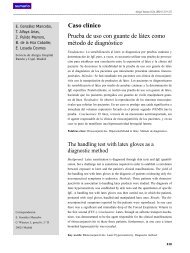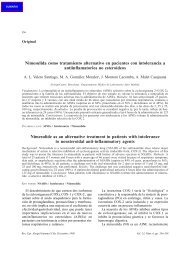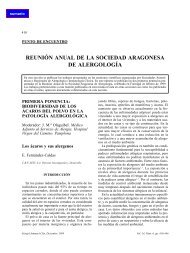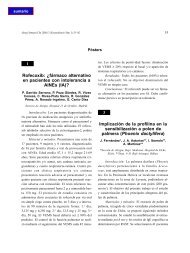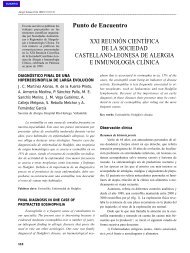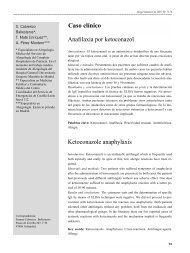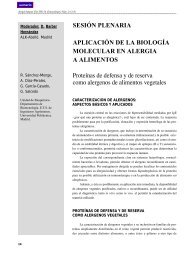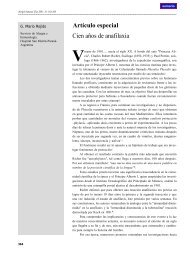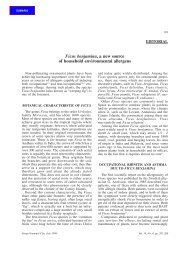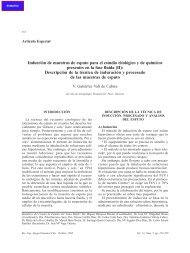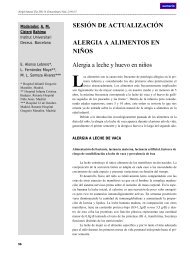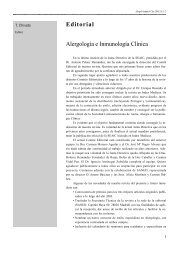Antihistamines: a review
Antihistamines: a review
Antihistamines: a review
You also want an ePaper? Increase the reach of your titles
YUMPU automatically turns print PDFs into web optimized ePapers that Google loves.
304 I. J‡uregui Presa Volume 14<br />
Table II. Chemical classification of the H1 antihistamines 15,24,26<br />
Drug Dose Plasma elimination Skin test Protein binding Clearance<br />
(mg/day) half-life suppression (%) (ml á min -1 á kg -1 )<br />
Acrivastine 16 - 24 ~2 hours 8 hours 50 4.41<br />
Astemizole 10 - 20 12 - 20 days 6 - 8 weeks 97 11.0<br />
Azelastine (oral) 4 - 8 22 - 42 hours 1 week 77 - 88 8.45<br />
Bromphenyramine 9 - 18 24.9 hours 3 - 9 hours<br />
Chlorphenyramine 6 - 12 24.2 hours 24 hours<br />
Clemastine 2 - 3 7 - 12 hours 10 - 24 hours<br />
Cetirizine 10 7 - 10 hours 24 - 72 hours 93 - 98 0.8<br />
Hydroxyzine 75 20 hours 2 - 36 hours<br />
Ebastine 10 15 hours 28 hours 97.7 1.3 - 2.0<br />
Levocabastine<br />
Nasal spray 0.6 35 - 40 hours 10 - 12 hours 55 0.43<br />
Eye drops 0.2 35 - 40 hours 4 hours<br />
Loratadine 10 8 - 24 hours 12 - 14 hours 97 - 99 ?<br />
Mizolastine 10 14.5 hours 24 hours 1.15<br />
Noberastine 10 15 hours 32 - 72 hours<br />
Terfenadine 120 17 hours 24 - 72 hours 97 8.8<br />
Fexofenadine 120 - 180 14.4 hours 24 - 72 hours<br />
The reported arrhythmia associated to astemizole<br />
and terfenadine is a polymorphic ventricular tachycardia<br />
known by the name of torsades de pointes<br />
because of its changing electrical axis in the ECG,<br />
with waves of alternating amplitudes and directions<br />
(Figure 2). Torsades de pointes may appear as acute<br />
episodes with haemodynamic compromise and<br />
even sudden cardiac death 39 and are associated to a<br />
lengthening of the QT interval in the sinus rhythm<br />
ECG. The QT interval itself depends on the duration<br />
of the cardiac action potential, which is in its<br />
turn dependent on the ionic currents and fluxes in<br />
the myocardium and most particularly on the socalled<br />
potassium rectifier channel 40 .<br />
As already pointed out, terfenadine is a prodrug<br />
acting through its acid metabolite (terfenadine<br />
carboxylate, or fexofenadine), and this conversion<br />
occurs through a CYP3A4-dependent hepatic<br />
first-pass metabolism. Terfenadine is a potent<br />
blocker of the potassium rectifier channel 41 . Its<br />
accumulation in the organism because of overdosage<br />
or of the concomitant administration of other<br />
substrate drugs or CYP3A4 inhibitors may lengthen<br />
the heart rate-corrected QT interval (QTc). If<br />
the concomitant drug is erythromycin, which is at<br />
the same time a CYP3A4 substrate and a<br />
CYP3A4 inhibitor 33 and also a potassium rectifier<br />
channel blocker 35 , the heart repolarisation derangements<br />
will be even more marked.<br />
This effect might perhaps be shared by all the<br />
piperidine antihistamines 42 , but it has been<br />
demonstrated mainly with astemizole, terfenadine<br />
and ebastine 43 at a dosage one- to fourfold the respective<br />
peripheral antihistamine one although not<br />
with the active metabolites fexofenadine and carebastine,<br />
in experimental models 44,45 . Nevertheless,<br />
an isolated clinical observation has been published<br />
of torsades de pointes and lengthened QT<br />
interval in a patient with indetectable levels of<br />
astemizole and "therapeutic" concentrations of its<br />
major metabolite demethyl-astemizole 46 .<br />
Cetirizine, an active metabolite of hydroxyzine,<br />
does not prolong the QTc interval at dosages up to<br />
sixfold the indicated therapeutic ones 47 . Loratadine<br />
has the same interactions with macrolides and<br />
imidazoles as the other piperidines, yet this does<br />
not induce clinically significant changes in the<br />
QTc interval 48,49 . It has been reported that loratadine,<br />
contrary to astemizole, terfenadine and ebastine,<br />
does not block the potassium channels even at<br />
concentrations 100-fold its normal plasma level 50 .<br />
Even so, and according to WHO drug surveillance<br />
data, loratadine and cetirizine have also been<br />
associated, though much less frequently than terfenadine<br />
or astemizole, to reports of sudden or<br />
cardiac death 51 . There are also recent experimental<br />
studies suggesting that loratadine might be able to<br />
block certain potassium channels 52 .




